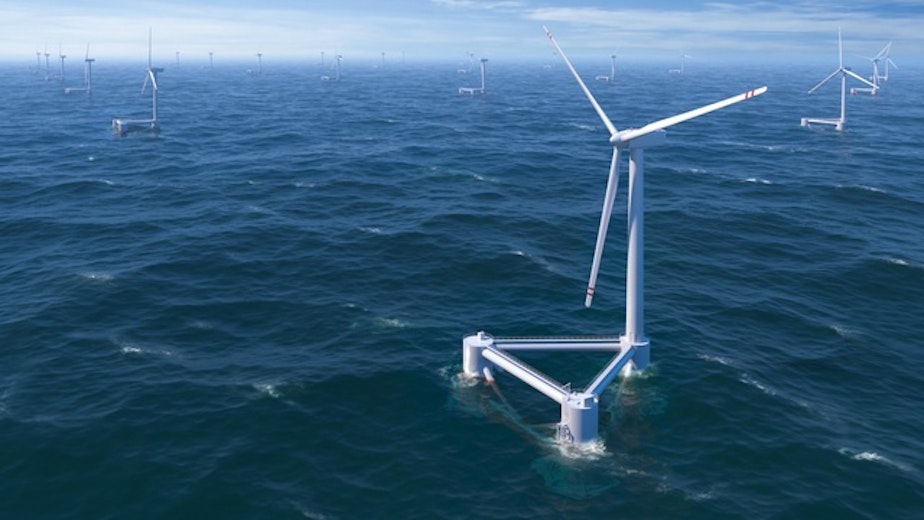Floating Wind Farm Off Southern Oregon Coast Gets A Green Light

A Seattle company that wants to build a floating wind farm off the shore of Southern Oregon got a green light from some high-ranking officials on Wednesday.
Interior Secretary Sally Jewell, Oregon Gov. John Kitzhaber and Tommy Beaudreau, director of the Bureau of Ocean Energy Management, ushered in a new phase of development for Principle Power, Inc.
The 30-megawatt project would be sited 18 miles off the shore of Coos Bay in about 1,400 feet of water. One power cable would connect the turbines to shore.
The company is still at the starting line of a long permitting process, officials said, but it is now clear to submit formal plans to install five floating wind turbines within a 15-mile area.
"Here in the Pacific you have tremendous wind," Jewell said. "I have flown kites myself on the Oregon coast, and it gets even windier as you get offshore. ... This pioneering project would demonstrate floating wind turbine technology capable of tapping the rich wind energy resources in deep waters offshore Oregon."
Sponsored
While other companies are working on offshore wind projects in the U.S., Jewell said, the Principle Power project would be the first offshore wind project on the West Coast and the first in the country to use floating turbine technology.
A similar project is operating off the shore of Portugal.
Kitzhaber said the project presents "a tremendous chance to demonstrate we can create economic activity and good, well-paying jobs that can't be outsourced without sacrificing environmental stewardship."
The U.S. Department of Energy awarded Principle Power $4 million in funding to develop the pilot project in 2012. The company submitted its request for an offshore commercial lease last year. Regulators invited public comment on the request and determined that no competitors have an interest in that lease area. Thus, the company is free to proceed with the permitting process.
Beaudreau said permitting the project "is going to take some time" – at least two years – though "there's no set timeline."
Sponsored
"It is an exciting day for this," he said. "I'm very pleased to be rolling out renewable energy development on the West Coast as we have been on the East Coast for several years now."
The company met with stakeholders including commercial fishing groups before the announcement in Portland.
Brad Pettinger, director of the Oregon Trawl Commission, was among those at the meeting. He said he's worried about the potential impacts the offshore wind farm might have on trawl fisheries, but he is going to work with the company to test out the technology.
"The company said all the right things," Pettinger said. "We have some concerns. There are a lot of unknowns. So, let's get one out there and see if it works."
Kevin Banister, vice president of government affairs for Principle Power, said his company has been developing plans for the project for two years. The company met with commercial fishing groups during that time to choose a site with minimal impacts to fishing grounds – though it was a little farther offshore than the 10-15 miles the company had targeted.
Sponsored
"We deferred to them in siting the project," he said.
Banister said building offshore turbines makes sense because there's lots of wind and more room to accommodate ever larger turbines.
"There are outstanding wind resources offshore," Banister said. "Every time you scale up, it becomes harder and harder to do it on land. The economies of scale really come into play."
The company is reviewing potential impacts to species such as great whales and short-tailed albatross.
"We think this is going to be a pretty benign project," he said.
Sponsored
The company is in discussions with developers of the Jordan Cove liquefied natural gas project, which might utilize the power from the offshore wind farm. Banister said he's hoping the project will be up and running by 2017.Copyright 2014 EarthFix. To see more, visit earthfix.kuow.org.
